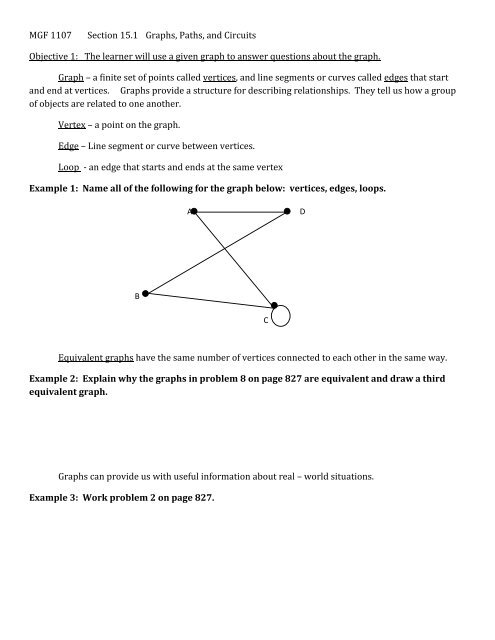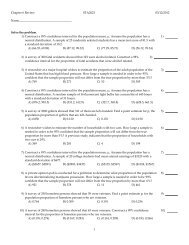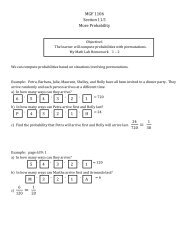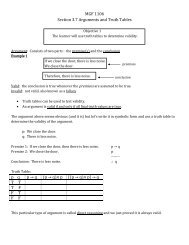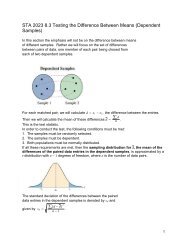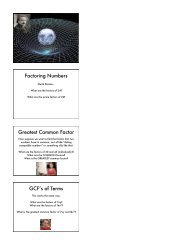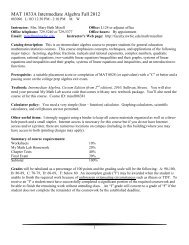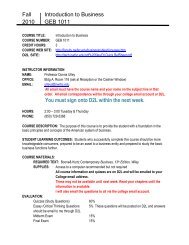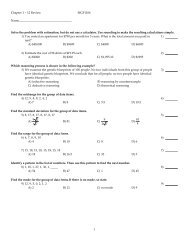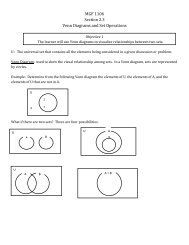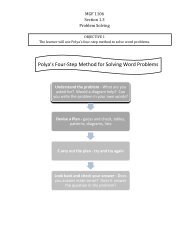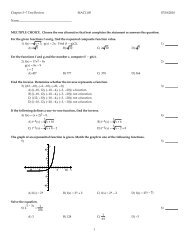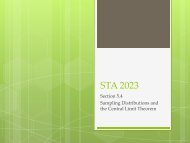MGF 1107 Section 15.1 Graphs, Paths, and Circuits Objective 1: The ...
MGF 1107 Section 15.1 Graphs, Paths, and Circuits Objective 1: The ...
MGF 1107 Section 15.1 Graphs, Paths, and Circuits Objective 1: The ...
Create successful ePaper yourself
Turn your PDF publications into a flip-book with our unique Google optimized e-Paper software.
<strong>MGF</strong> <strong>1107</strong><br />
<strong>Section</strong> <strong>15.1</strong> <strong>Graphs</strong>, <strong>Paths</strong>, <strong>and</strong> <strong>Circuits</strong><br />
<strong>Objective</strong> 1: <strong>The</strong> learner will use a given graph to answer questions about the graph.<br />
Graph – a finite set of points called vertices, <strong>and</strong> line segments or curves called edges that start<br />
<strong>and</strong> end at vertices. <strong>Graphs</strong> provide a structure for describing relationships. <strong>The</strong>y tell us how a group<br />
of objects are related to one another.<br />
Vertex – a point on the graph.<br />
Edge – Line segment or curve between vertices.<br />
Loop - an edge that starts <strong>and</strong> ends at the same vertex<br />
Example 1: Name all of the following for the graph below: vertices, edges, loops.<br />
A<br />
D<br />
B<br />
C<br />
Equivalent graphs have the same number of vertices connected to each other in the same way.<br />
Example 2: Explain why the graphs in problem 8 on page 827 are equivalent <strong>and</strong> draw a third<br />
equivalent graph.<br />
<strong>Graphs</strong> can provide us with useful information about real – world situations.<br />
Example 3: Work problem 2 on page 827.
<strong>Objective</strong> 2: <strong>The</strong> learner will draw a graph to model a specific situation.<br />
Example 4: Work problems 14, 16, <strong>and</strong> 19 on page 828.<br />
<strong>Objective</strong> 3: <strong>The</strong> learner will underst<strong>and</strong> <strong>and</strong> use the vocabulary of graph theory.<br />
Degree of a vertex – number of edges at that vertex.<br />
Special Case: A loop contributes two to the degree.<br />
Even Vertex – has even degree.<br />
Odd Vertex – has odd degree.<br />
Example 5: Classify each vertex as even or odd.<br />
A B C<br />
D E F
Adjacent Vertices - at least one edge connects the vertices<br />
Path – a sequence of adjacent vertices <strong>and</strong> the edges connecting them. An edge can only be part of<br />
a path once but vertices can appear more than once in a path.<br />
Example 6: Use vertices to describe three paths that begin at A <strong>and</strong> end at E .<br />
A B C<br />
D E F<br />
Circuit – a path that begins <strong>and</strong> ends at the same vertex.<br />
Example 7: Use vertices to describe three circuits that begin (<strong>and</strong> end) at A .<br />
A B C<br />
D E F<br />
Connected Graph – for any two vertices, at least one path (not necessarily an edge) connects them<br />
Disconnected Graph – a graph that is not connected. A graph that is not connected has separate<br />
pieces (called components) that are connected.<br />
Example 8: Explain why graphs a <strong>and</strong> b on page 826 are connected but graphs c <strong>and</strong> d are<br />
disconnected.
graph<br />
Bridge – an edge that if removed from a connected graph would leave behind a disconnected<br />
Example 8: Name the bridge in the graph below.<br />
A B C<br />
D E F<br />
Example 9: Work problems 34 – 48 on page 829.


